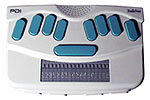Archives
Textbooks for blind students "come alive"
By LOIS BAKER
Contributing Editor
A standard textbook for primary or secondary school students is a robust learning tool rich with photographs, illustrations, charts, maps—visual images that bring the words to life.

BrailleNote
Textbooks for blind or visually impaired students are considerably less dynamic. A full book may comprise as many as 15-20 bound volumes. All of the helpful graphic components are useless unless the teacher describes them. Locating a highlighted vocabulary word is cumbersome and difficult.
The learning status quo for these students may be changing as the result of a project completed by assistive technology experts at UB.
With $400,000 in funding from the U.S. Department of Education, Kathleen A. Beaver, Christine Oddo and Sumana Silverheels spent the past two years developing a prototype social-studies electronic textbook—more precisely, 13 social-studies prototype electronic textbooks and 10 supplements for grades 2 through 10—that include text, as well as descriptions of all graphic elements.
The electronic files are designed for use with an ingenious, classroom-friendly device called a portable refreshable Braille note-taker. The device converts electronic text into speech and into Braille that is "refreshed:" produced as a ticker-tape-like continuous stream that is created by moveable pins on a keyboard, which the fingers read the way the eye would track words across a page. The student can listen to the textbook or read it in Braille.
The new electronic textbooks will be available for use in classrooms across the nation this spring.
"No other textbook out there for visually impaired students has been modified to this extent," said Beaver, associate director of the Center for Assistive Technology in the School of Public Health and Health Professions and project director of the Instant Access to Braille project.
"These are the only social studies textbooks available to blind students across the country that have all picture and map descriptions included," she said. "They also are the only ones designed to take full advantage of a portable note-taking device, where elements such as time lines, tables, bulleted lists, graphs and charts, highlighted vocabulary words, multiple choice and fill-in-the-blank chapter summary questions work equally well for output of both speech and refreshable Braille.
"And because the file is electronic," Beaver added, "students can search for information, such as vocabulary words, instead of skimming through page after page of hard-copy Braille. They also can place electronic 'bookmarks' within the text to quickly locate important material."
Beaver and her colleagues developed the electronic textbooks with the aid of 15 blind students in grades 2 to 10. Each student received a BrailleNote, a personal note taker with refreshable Braille developed by Pulse Data International to test at home and in the classroom.
The students' response was enthusiastic. "For the first time ever, I have been able to do my social studies homework independently, without asking my mom to describe the maps and pictures to me or have her help me find answers within the text," said one ninth grader.
Converting the words into an electronic format was easy, if time consuming. Beaver and colleagues dismantled each student's social studies book and scanned the pages into a computer. Recreating the graphic images was not as simple. Beaver and colleagues used their knowledge from a workshop on describing art for the visually impaired to devise descriptions of every graphic image in the printed book, each carefully worded to create a vivid picture in the mind's eye.
The colorful photo of an ancient Aztec mask in the 8th grade social studies textbook "Creating America," for example, comes alive for a blind student through these words:
There is a photograph on this page of a primitive facemask made out of blue mosaic tiles. Some of the small blue tiles are missing. The mask has big white eyes with dark pupils, a broad nose and a wide mouth with large, square, white teeth.
A picture isn't necessarily worth 1,000 words, it turns out. Sometimes just six suffice.
In "Creating America" alone, there are 394 photographs, 130 graphic organizers (visual tools such as flow charts and Venn diagrams that define patterns and relationships within the data), 115 historical maps, 42 charts, 32 timelines, 28 diagrams and 25 graphs. Beaver and her team created word pictures for every one, plus for graphic elements in 14 additional textbooks. They currently are finalizing the references and acknowledgements. The textbooks will be stored as zipped files at the American Printing House for the Blind in Louisville, Ky.
"Each state has one or more authorized entities, usually someone in the state education department, who can acquire the textbook for eligible students in that state," said Beaver. "The file then can be mailed or emailed to the teacher working with that student. Once the file is unzipped, it can be copied to a standard flash disk card or floppy disk and imported into the BrailleNote."
Electronic textbooks have the potential to provide all students access to the full vigor of instructional materials, Beaver stated. "As electronic textbooks become more available, electronic note takers with refreshable Braille not only will give students the freedom to study and learn independently, they will provide a cost-effective alternative to hard-copy Braille textbooks."
Beaver and her colleagues hope to use the textbook project to conduct research into the effect of the use of refreshable Braille on Braille literacy.
